
IV Education and Venipuncture Certification for California Radiology Technologists
This IV education & venipuncture certification course has been designed to provide basic conceptual and operational knowledge to Radiology Technicians, MRI Technologists, Ultrasound Technologists, and Sonographers in California who have had limited exposure to infusion therapy principles and practice. As the science of infusion therapy advances and technology expands, it is imperative that all healthcare clinicians practicing infusion therapy remain current in their knowledge of infusion therapies, principles, techniques, equipment and the latest in infusion evidence based practices.
Intravenous administration of contrast materials in the radiology setting brings forth another aspect to intravenous protocols and procedures. A Radiology Technologist may administer intravenous contrast media under the general supervision of a physician. In order to provide for the safe administration of contrast media, those persons administering contrast media and those performing the diagnostic imaging procedures must have an understanding of the indications for use of contrast media, the equipment needed for safe administration, as well as the potential risks and side effects and its management. These can all be provided with adequate IV education.
Many governing boards require the Radiology Technologist to have infusion therapy and venipuncture education after licensure. These requirements vary by state and governing board. This course provides 10 hours of didactic education and complies with California Health & Safety Code 106985, Section 27; Senate Bill No. 1199, and includes First Aid education.
The participant, if practicing in California, must also have a valid and current cardiopulmonary resuscitation (CPR) education.
Competency requirements are obtained and maintained through the healthcare provider's employer, facility or institution, with a preceptor. The number of times a procedure must be repeated to demonstrate competency will be determined by the employer or as stipulated by the governing agency of the profession. Pedagogy has developed skills competency checklists for all infusion related procedures and these are available in the course, for print out and completion with a preceptor.
Videos are included as a teaching component of this course and the participant will be required to have available access to YouTube to view the videos.
If you are not practicing in California, please see our IV Education and Venipuncture Certification for Radiology Technologists course!
Questions? Check out our FAQs page and How Online IV Certification Works!
Objectives
Upon completion of this course, the participant will be able to:
- Identify infusion related complications, causes and appropriate treatment.
- Identify methods of infection control related to IV therapy.
- Demonstrate IV insertion, catheter removal, and Infusion related procedures.
- Review anatomy and physiology of the vessels used for the administration of contrast media.
- List the appropriate steps in establishing an IV infusion.
- List the standard components of an anti-anaphylaxis tray.
- List appropriate treatments of contrast media reactions.
- Describe and demonstrate how to control different types of bleeding.
- Describe and demonstrate how to assess, recognize, and treat different types of wounds.
- Recognize basic elements of common injuries and emergencies.
- Recognize and respond to common illnesses.
Curriculum
Section One - IV Education and Venipuncture
Chapter 1: Legal Issues
- Senate Bill No. 1199; An act to amend Section 106985 of the Health and Safety Code, relating to radiologic technologists.
- Regulatory Agencies and Governing Bodies
- Components of a Complete Order
- Legal Terms and Applications
- Protective Measures for Guarding Against Malpractice Lawsuits
Chapter 2: Anatomy and Physiology
- The Vascular System: Veins, Arteries and Bone Marrow
- The Three Layers of the Vessels and Their Function
- Differentiating Arteries from Veins
- Veins Used in Peripheral Intravenous Therapy for Pediatrics and Adults
- Intraosseous
- Skin ‐ Anatomy and Physiology
Chapter 3: Psychological Needs of the IV Patient
- Age Specific Needs
- Elderly Patient Needs
- Cultural Aspects
- Patients with Sensory Deficits
- Methods of Reducing Patient Anxiety
- Patient Teaching/Education
Chapter 4: Fluid and Electrolyte Balance
- Water: The Primary Fluid of the Body
- Hypovolemia - Dehydration: Assessment, Causes, Treatments
- Hypervolemia - Fluid Overload: Assessment, Causes, Treatments
- Fluid Compartments
- Electrolyte Imbalances: Assessment, Causes, Treatments
Chapter 5: pH, Osmolality and Incompatibilities of Solutions and Medications
- pH of Intravenous Solutions and Medications
- Tonicity: Isotonic Solutions, Hypotonic Solutions and Hypertonic Solutions Incompatibilities
- Contrast Agent Osmolaility
Chapter 6: Fluid Regulation
- Methods of Fluid Regulation
- Patient Considerations in Fluid Regulation
- External Factors that Affect the Rate of Flow
- Calculation of IV flow Rates
Chapter 7: Infection Prevention and Safety Compliance
- Hand Hygiene
- Sharps Management
- Medical Waste Disposal
- Durable Medical Equipment Disinfection
- Standard Precautions
- Transmission-Based Precautions
Chapter 8: Vascular Visualization
- Trans-illuminator Technology
- Near Infrared Technology
- Ultrasound
Chapter 9: Site Selection and Device Placement
- Criteria For Peripheral Devices
- 3 Types of Peripheral Access And Criteria For Placement
- Special Considerations of The Specific Age Groups
- General Considerations of Short Peripheral Access
- Veins to Avoid
Chapter 10: Vascular Access Device Management
- Needleless Connectors
- Filtration
- Add-on Devices
- VAD Stabilization
- Joint Stabilization
- Site Protection
- Flushing and Locking
- Assessment, Care, and Dressing Changes
- Administration Set Changes
Chapter 11: Complications
- Local Complications
- Hematoma
- Infiltration
- Extravasation
- Phlebitis
- Site Infection
- Catheter Occlusion
- MARSI
- Nerves - Avoiding Damage
- Compartment Syndrome
- Systemic Complications
Chapter 12: Procedures Guides and Videos
- Pre-insertion Procedures
- Peripheral IV Insertion
- Primary/Hydration Administration Set-up
- Catheter Discontinuation
Chapter 13: Assessment and Documentation
- Catheter Insertion Documentation
- Catheter Removal Documentation
- Assessment, Monitoring and Documentation
Chapter 14: Treatment of Contrast Reactions
- Identifying Mild, Moderate and Severe Reactions
- Acute Contrast Reaction Management
- Anti-Anaphylaxis Trays
Chapter 15: Resources
- Skill Check-Off Lists
- Peripheral IV Insertion
- Large Volume Electronic Infusion Device
- IV Push
Section Two - Basic First Aid
Chapter 1: Introduction
- What you will learn
- Successful completion of this course
- Course objectives
- Responsive versus unresponsive person
- First aid terms
- What is first aid?
- Responsive
- Unresponsive
- Agonal gasps
- Cardiopulmonary Resuscitation (CPR)
- Compression
- Automatic External Defibrillator (AED)
- Adult
- Child
- Infant
- Phone for Help
Chapter 2: Basic First Aid
- Roles and responsibilities
- Your role
- Giving first aid
- First aid kit
- Automatic external defibrillator (AED)
- Good Samaritan laws
- How to respond to an emergency?
- Is the scene safe?
- When to call
- Who should help
- Universal precautions
- Gloves
- Gown
- Mask
- Goggles
- Donning and removing gloves
- Handwashing
- Steps to handwashing
- Soap and water
- Hand sanitizer
- Recognizing an emergency
- Moving the ill or injured
- Foot drag
- Shoulder drag
- Blanket drag
- Section Review
Chapter 3: Emergencies
- Type of emergencies
- Stroke
- Signs of a stroke
- Learn more about strokes
- What do I do?
- Seizure
- What do I do?
- What type of first aid?
- Bleeding from the mouth
- Heart attack
- Signs and symptoms
- Chest discomfort
- Symptoms vary between men and women
- What do I do?
- Choking
- Signs and symptoms
- What do I do?
- Allergic reactions
- Signs and symptoms
- What do I do?
- Breathing difficulties
- What is a rescue inhaler?
- How to assemble and use and inhaler
- Diabetes
- Signs and symptoms
- Low blood sugar
- What do I do?
- Section Review
Chapter 4: Injuries
- Head, neck, and back injuries
- Signs and symptoms
- What do I do?
- Neck and back
- Burns and electrical injuries
- Burns
- Electrical injuries
- Nose bleed
- Internal and external bleeding
- What do I do?
- Signs of shock
- Sprains, strains, and broken bones
- Section Review
Chapter 5: Environmental Emergencies
- Animal bites, snake bites, and bee stings
- Heat related problems
- Heat cramp
- Heat exhaustion
- Heat stroke
- Cold related problems
- Frost bite
- What do I do?
- Poisons
- Emergency action for poisoning
- First steps after an accidental exposure
- Information the poison center specialist will need
- Eye injury
- Section Review
Chapter 6: Reference
Price: $175.00
Contact Hours: 10

Course Author

Capra Garrison
Course Accreditation
The AVIR is a Recognized Continuing Education Evaluation Mechanism (RCEEM) for the American Registry of Radiologic Technologists (ARRT). This educational activity is approved by the AVIR for ARRT Category A+ Credit for 10.00 contact hours. CE accreditation approval date 10/09/2023 through 10/09/2026.
Course complies with California Health & Safety Code 106985, Section 27; Senate Bill No. 1199.